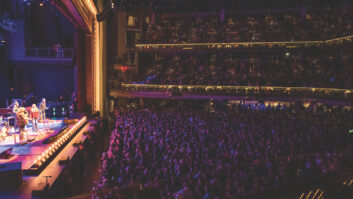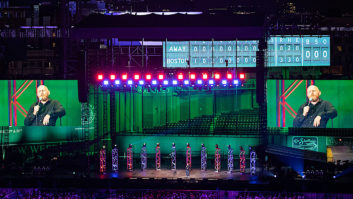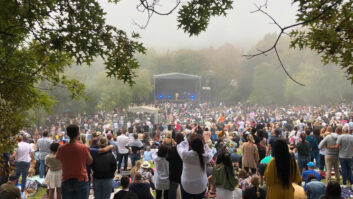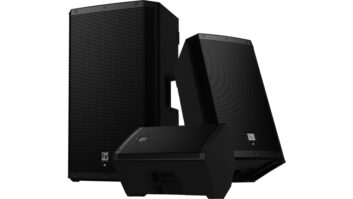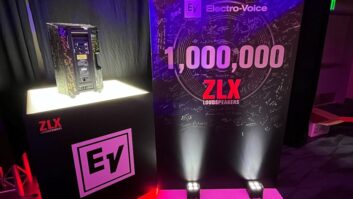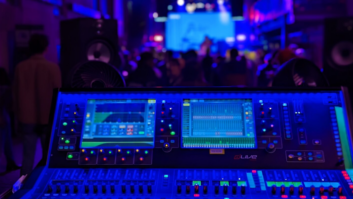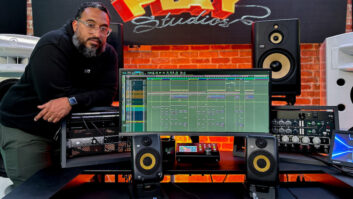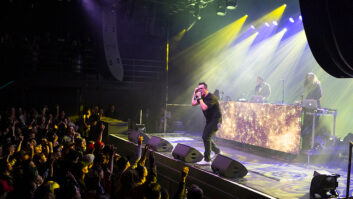Boston, MA (October 13, 2010)–Southwest Louisiana-based Gulf Coast Sound Productions (GCS) recently fielded a 100-box Electro-Voice sound system at Boston’s Fenway Park for the premiere of the new Ben Affleck film The Town.

Incorporating three line arrays, surrounds, and a massive complement of subwoofers, the system provided the 5.1 channel soundtrack to the park.
When the film’s producers settled on the premiere’s unconventional setting, event projection specialists Boston Light & Sound (BLS) were brought in to oversee technical aspects of the screening. “We actually like going into places where people think you can’t do a good job showing a movie, and Fenway Park was one of those,” says BLS’s Chapin Cutler.
BLS designed an Electro-Voice line array system to cover seating for about 2,500 behind the third-base dugout. “A decade ago, we worked with the late Monte Wise at ShoWest on what was probably the first use of a line array for Dolby Digital theatrical playback,” Cutler says, “and ever since then, we’ve been using Electro-Voice arrays whenever we can. The pattern control we get with these arrays means that we can control sound levels very precisely from front to back and deliver superior intelligibility across a large area. So we’ve been a believer in EV speaker systems for many years, and we selected Gulf Coast because they are an EV provider and we knew from previous experience that they are a terrific company to work with.”
The key technical challenge for the system, which was modeled by BLS’s Michael Rome using Electro-Voice’s Line Array Prediction Software (LAPS), was to recreate both the power and the nuance of the soundtrack in a setting designed for baseball rather than sound. “Movies are very dynamic,” says Larry Habetz, founder and owner of GCS. “You touch on so many different aspects of the audio range, from mild to wild, from a whisper to an explosion. Some company’s boxes sound great doing a particular style of music, like rock and roll, because their characteristics complement those kinds of sounds, but there may be other types of sound that they don’t handle as well. For a movie, your speakers have to be able to do it all. They have to be able to reproduce all the dynamics as accurately as possible, and to shine in all aspects.”
Judged by these criteria, Habetz says, the Electro-Voice system “really did a great job. I was sitting in the very back with the projection fans blowing right next to me, and, even when the characters were talking quietly among themselves in their thick Boston accents, I could hear every word and every subtle detail, like the rustling of clothes and the leaves in the trees. But the movie also has lots of gunfire, explosions, and car chases, and the intelligibility from one dynamic to the other was really amazing. Our system really brought the movie to life. And what’s particularly great is that my clients told me they felt the same way about it.”
Habetz reported, “One of the Warner Bros executives said to my client that this was probably the best-sounding premiere that he had been to.” Tom Kodros from Dolby Laboratories and Charlie Greenough from Boston Light & Sound tuned the system, using the “X-curve” as the basis for tuning the system for film playback. “Kodros said that he had never really been exposed to EV systems before, and that this had made a believer out of him,” Habetz adds.
“We received nothing but compliments,” agrees Cutler. “The venue’s acoustics were about as unsuitable as possible, and yet the sound was absolutely superb. The sound editor was thrilled, the mixer was thrilled, the producer and the director and the studio were all thrilled. Everybody was happy.”
The specifics of the system configuration were largely driven, Habetz says, by the goal of providing the most even coverage from the front seats to the back, as well as the requirement for at least 20 dB of headroom above the nominal theatrical-standard operating level of 85 db SPL. “They want the ability to provide that dynamic range without stressing any components in the signal chain.”
The left, center, and right channels of the soundtrack were handled with three line arrays, each composed of 12 XLC127DVX three-way, high-output compact line-array elements. oversaw the crew “We had to build a grid over the third-base dugout, and each box had to be lifted up there before being flown. If the boxes were big and heavy, or the rigging wasn’t user-friendly, it would cost us in time and labor to put up those arrays. So we chose XLC127s for their intelligibility and ease-of-rigging, and because they pack a lot of horsepower in a small size. We’ve had a great return on our investment in those boxes, because EV designed them with upgradeable electronics, so even the first units we purchased seven years ago are still cutting-edge technology today.”
For the low end, the system combined 16 Xsub dual 18-inch subwoofers with 24 XLC-118 high-output subwoofer line-array elements that Habetz says were “used as a kind of bridge between the 12-inch drivers in the XLC127DVXs and the dual-18s in the Xsub.” With a total of 56 18-inch drivers stacked behind the screen, he adds, “we moved some substantial air. The impact was huge — you could feel the park literally shake during the explosions — so it really had that larger-than-life, Hollywood feel.”
For left and right surround channels, 24 XLE181s were deployed in groups of four at three locations on each side of the seating area. “We wanted nice dynamics with controlled coverage to get a smooth transition from the closest seat to the farthest. And we needed something that was light but with good horsepower. The XLE181s are only 38 pounds, but they have a lot of bang for their size and a lot of bang for the buck. So it worked out great.”
Overall installation coordination for the undertaking was provided by Celine Larimer with the assistance of Daniel Beedy, both from BL&S. As a sound engineer and the technical liason for the project, Larimer was able to coordinate the efforts of all parties in the project with the many departments at Fenway Park. “When dealing with an historic structure like Fenway, and the huge concern for protecting the ball field itself, the logistics for this project were daunting,” she says. “Because of our long standing relationship with the Park, we were able to work with them in hanging the surround arrays from the roof overhang and bring a level of comfort to the Park management,” she adds. It is believed this event was the first time a film has ever been run in Fenway Park.
To power all those loudspeakers and maintain the required headroom, the system incorporated 60 Electro-Voice P-RL amplifiers. “We have been using these amps for years, largely for outdoor festival work.” Habetz says. “They bounce around in the back of the truck and they are very robust on the road. But they also deliver a lot of dynamics with very low noise. The movie people were really on the lookout for hiss and other noise, but when our rig was fired up they walked around and they couldn’t hear anything.”
The amps’ on-board DSP was used for limiting and some time alignment, while the rest of the system processing, including FIR filtering to optimize the signal for each speaker model, was applied via an Electro-Voice NetMax N8000-1500 digital matrix controller. “NetMax is phenomenal,” Habetz says. “It does so much, and we’re not even scratching the surface of what it can do. We have a tablet computer attached to the NetMax via WiFi, and after it rained and there was some concern that the sound had changed, we were able to remotely pull up the real-time status of each amp to show that the system was operating normally, and that the change was due to water on the perforated screen.”
Electro-Voice
www.electrovoice.com
